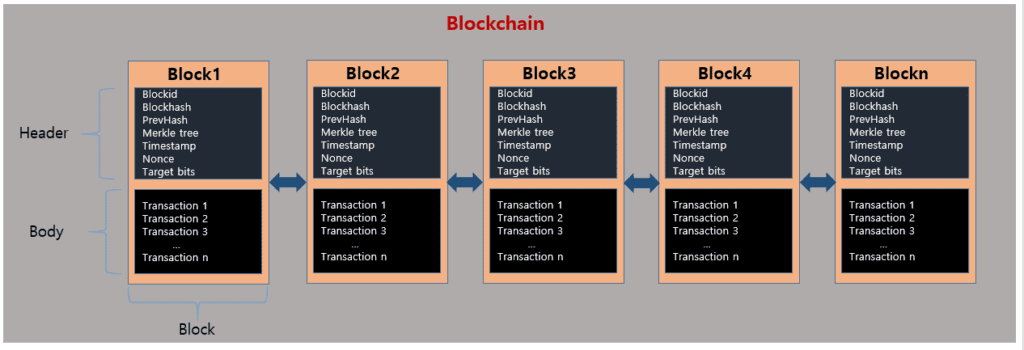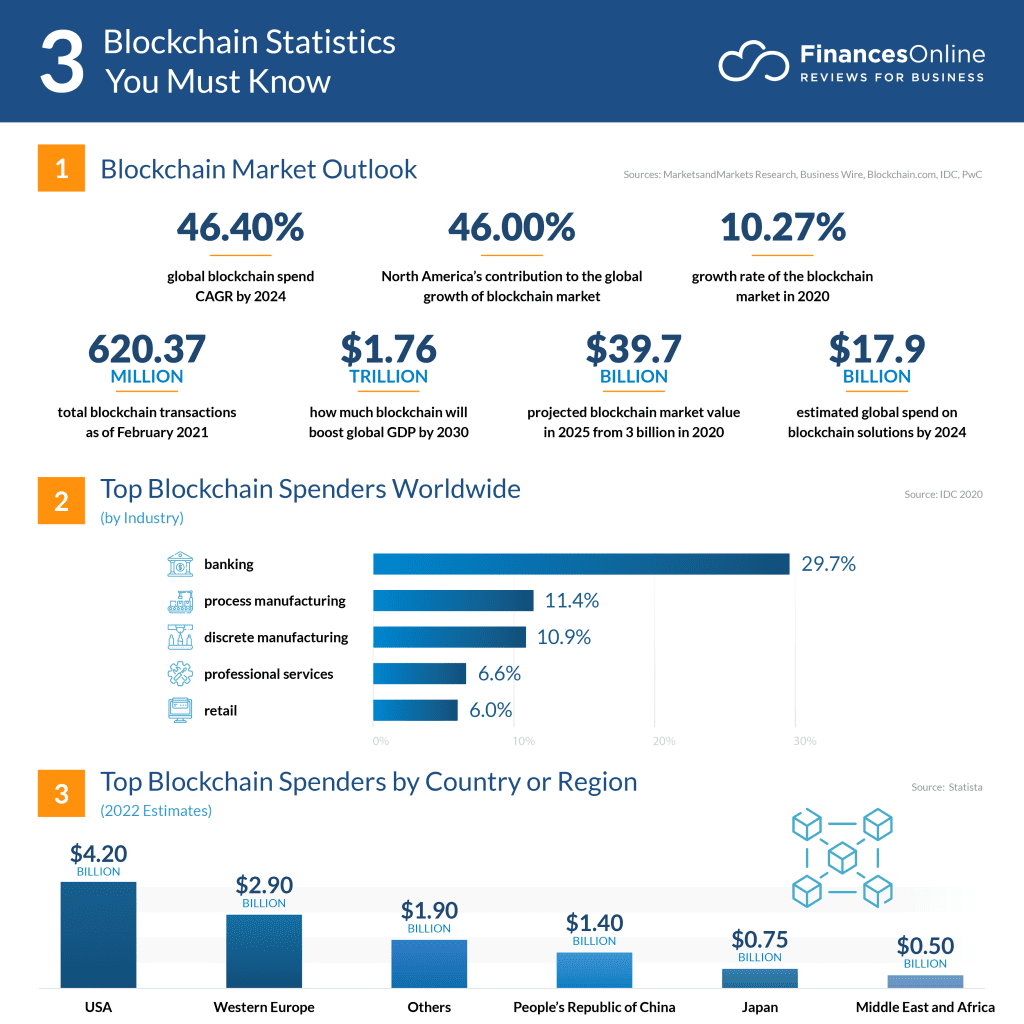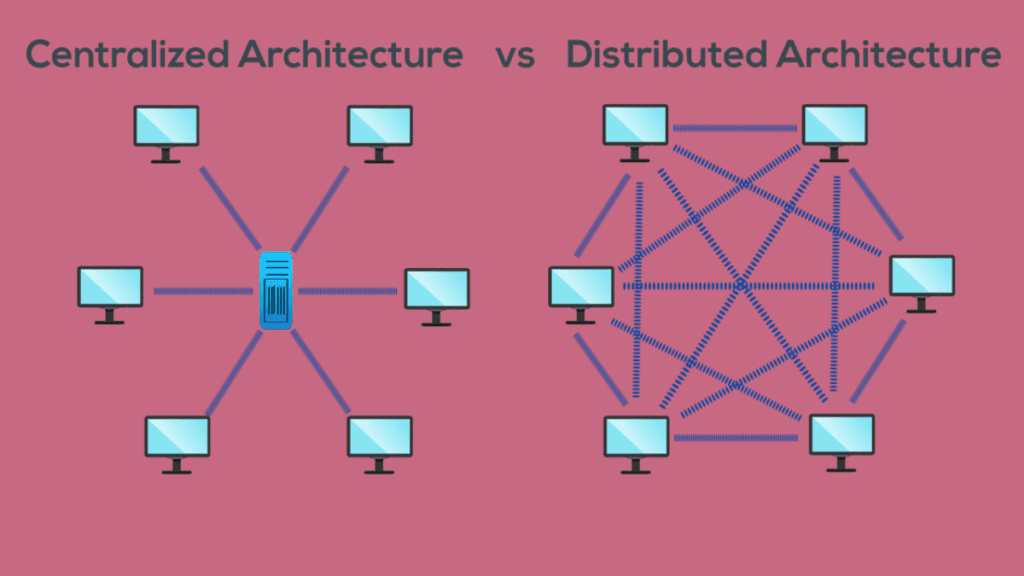How to create a blockchain application
More than 10 years have passed since Bitcoin made the world aware of blockchain. Since then, there have appeared many derivative projects not related to digital money. Blockchain is successfully used in real estate, healthcare, logistics, cybersecurity, and other industries. Its potential is so huge that Statista predicts a 100-fold growth in the technology market, from $1.57 billion in 2018 to $163 billion in 2027. In this article, we will concentrate on the main issues of blockchain app development.
Blockchain: reliable protection of any transactions
Blockchain is distributed ledger technology that processes transactions and stores states. Each ledger contains a chain of blocks that are similar to tables in a database (see the infographic below).

Source: medium.com
Blocks contain transactions, a timestamp, the hash of the previous block, the hash of the current block, and other information. This data cannot be deleted, forged, or updated. It is protected by a unique identifier (hash) and a digital signature. Blocks are difficult to hack. That is why blockchain is a good choice for projects related to finance and sensitive data storage.
What is blockchain based on?
Blockchain is changing the way information is stored. Imagine that data is a spreadsheet. In the past, employees had to “juggle” documents to keep up-to-date information in an Excel file. One person worked on such a file, saved it, and passed it on to their colleague. They were waiting for the partner to work with the spreadsheet and send it back to check the changes and continue editing.
Blockchain in this context means Google Sheets when several people work at the same time. Data is not lost and is synchronized online. Document versions are traceable by all participants. In addition to these properties, there are three fundamental features that programmers consider when developing a blockchain application:
- Scalability. This property determines how stable a blockchain is under different loads when the system is scaled.
- Decentralization means that the platform is not managed by a trusted third party (a bank or other institution). Participants act within the framework of consensus, which determines the rules of conduct. An agreement establishes how network users must jointly make decisions, confirm a block and reject an attack.
- Security is the third main feature of blockchain. A hash (unique identifier) is assigned to each block. It also performs the function of protection because it encrypts the data in blocks using a cryptographic algorithm. Each block contains its own hash and the hash of the previous block. When a new block is created, it triggers a series of changes in the chain. In particular, hashes in all blocks change. Therefore, guessing the secret key is almost impossible.
Types of blockchain
Before starting blockchain app development, it is worth understanding what type of technology suits your project. It depends on how programmers build the work and what additional technologies they use. Blockchain networks can be:
- Public (Bitcoin, Ethereum). A network to which everyone joins on equal grounds. Each participant views the history of transactions and acts within the framework of consensus. Most of the network’s clients are easy to identify.
- Private (Mijin). Network users also have equal rights, but only privileged persons can view the history of the chain. Permission is issued by special validators. Transactions in such a network are processed faster than in a public one. This type of blockchain is suitable for corporate projects.
- Hybrid (R3 CEV, Bitshares). Network members are equal, but only selected users are allowed to add new blocks to the chain. Everyone is viewing the transaction history, but some entries are hidden. Such a network is used by firms that maintain the confidentiality of customers.
- Consortium blockchain. A network is managed by two or more enterprises. Organizations determine who is allowed to complete transactions and view the history. Such an alliance includes financial institutions and blockchain development companies that create a blockchain together.
The popularity of blockchain development
While digital currency has been the most popular use case for blockchain, businesses are reevaluating the application of this technology. In 2021, 45% of Statista survey participants reported that organizations want to adopt this innovation for trusted communication.
The banking industry (30%) and manufacturing (11.4%) are primary investors in blockchain.

Source: financesonline.com
According to Statista, by 2024, spending on blockchain will triple compared to 2021 and amount to $19 billion.
The popularity of blockchain app development is evidenced by the amount of funding for the technology. In the first quarter of 2021 alone, blockchain startups raised more venture capital investments than in the entire 2020 — $2.6 billion.
What is the difference between developing a blockchain application and creating a standard application
Externally, a blockchain platform is no different from a classic application. The difference lies within the program. When developers design blockchain-based software, they create a decentralized system.
A traditional application is built on a client-server architecture. A user (client) can change the information that is stored on the centralized server. The database is managed by a responsible authority that verifies customer details and grants access to the database.
A blockchain app is decentralized. This means that the database is a network of distributed nodes. Nodes validate new transactions or a new block. To add information, most nodes must reach a consensus – an agreement.

Source: merehead.com
Developers use a programming language that is suitable for building a blockchain. At the start, they also determine the approach needed to design the application:
- Development of a blockchain platform based on which other programmers will create software.
- Creation of one’s own blockchain software for analysis and data collection.
- Designing special software (plugins, protocols) that integrate with blockchain or dApps protocols.
How to develop a blockchain application: a step-by-step plan
Creating a blockchain application, like any other software, involves some steps. Developers take them to create a product relevant to the customer’s request. When developing a blockchain, you need to:
- Decide on the purpose of blockchain development, the type of network, and the level of anonymity. The choice of chain architecture, technologies, duration, and complexity of the project depends on these indicators. For example, a project to develop a new digital currency is significantly different from building a private banking network.
- Choose a consensus model. The team knows how the customer will use the blockchain. Developers then need to decide on a consensus mechanism. They must define the rules by which the participants in the blockchain will cooperate.
- Find the right platform. If the team is not creating a blockchain solution from scratch, they need to choose a platform on which to build a new application. They may opt for BigChainDB, Elements Blockchain, Ethereum, and others.
- Decide on tech stack. The team chooses an appropriate language to design the blockchain (Golang, PHP, Javascript, or others). They define where to distribute nodes: to the cloud, locally, or combine these options. They also specify the operating system or mobile platforms through which the user will interact with the application. The team plans which external databases (MySQL, MongoDB) and servers (web, FTP, or mail servers) to use.
- Design a blockchain.
The initial steps for the project are:
- creating a class for processing blocks when launching nodes;
- setting up local synchronization of the chain;
- defining algorithms for creating new blocks and connecting with the previous ones;
- fixing the requirements for the block hash structure;
- writing a consensus algorithm.
After setting up the necessary elements, you need to create an API if there are no ready-made interfaces. They are necessary for key and address generation, data authentication, information storage and retrieval, smart contracts, and other functions. It’s not a bad idea to add new technologies to the blockchain structure: AI, biometrics, chatbots, cloud solutions, and other innovations.
What specialists are needed for blockchain development
Depending on the scale and complexity, a crypto project can be led by up to a hundred specialists of various profiles. But to start you need a mandatory minimum:
- Developer. An expert on whose experience and knowledge the project is based. Blockchain can be developed in C++, Java, C#, JavaScript, Go, Python, Ruby, or other programming languages. Moreover, smart contracts are written only on Solidity. This means that if one programmer works on a project, then they need to know Solidity.
- Tester. A blockchain application, like any other software, needs to be checked for quality. QA specialists conduct unit and integration testing, UI testing, and API testing. There are also special tools for finding defects in software: Ethereum Tester, BitcoinJ, Populus, and so on.
- UX/UI designer. This specialist makes sure that a blockchain application is not only aesthetically beautiful but also convenient to use. They think through the logic of client interaction with the software, conduct UX research, and improve user experience.
- Project manager. Like any traditional project, a crypto project has a deadline, a scope of tasks, and a price. The time-cost-time triangle is managed by the project manager. This specialist leads the development team from project start to completion. They prevent risks that arise along the way and provide the customer with reporting on the work done.
- Business analyst. This team member is responsible for fulfilling the business goals of the blockchain project. They find out customer requirements for the product and fix them in the documentation. They also study market trends and recommend which features should be included in the software. They know how businesses can make more money with less spending on blockchain app development.
If the blockchain will work in the cloud, it is worth involving Cloud Engineers. For highly sensitive products, a cybersecurity specialist will be necessary. To work with big data, it is useful to involve Data Scientists in the project. And if the team operates according to the DevOps methodology, an experienced DevOps engineer may be needed. They will set up a CI/CD pipeline and environments for the work of developers and testers. They will organize the process so that a blockchain app is quickly and seamlessly deployed and released to production.
Conclusion
Blockchain is one of the most powerful and popular technologies. Organizations strive to master innovation, but not everyone succeeds. As of 2020, 39% of CEOs in 14 countries stated they had implemented blockchain in production. Therefore, it is worth occupying a free niche to be one step ahead of your competitors.
The security and transparency that distributed ledger technology provides can be applied in a variety of ways. To learn about these options, consult with an experienced blockchain app development team. Experts will analyze business opportunities, estimate the cost of the project, and create a suitable decentralized application.
